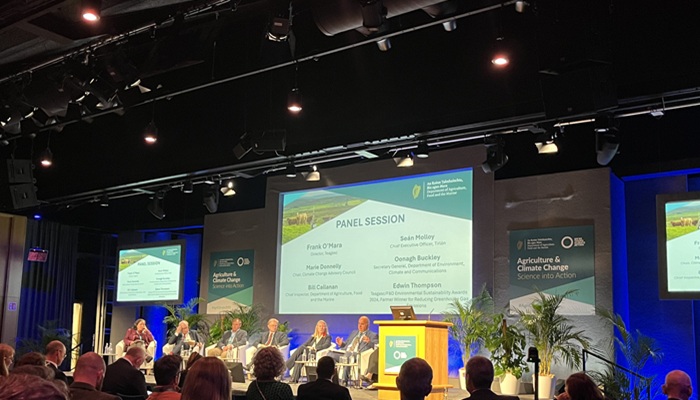09 June 2025
Farmer buy-in key to ag emissions journey
The vital role farmers play in meeting Ireland’s binding agricultural emissions reduction targets was a key topic of discussion at the Department of Agriculture, Food and the Marine’s Climate Change: Science into Action Conference, held in Dublin Castle on June 5.
Although much of the proceedings focused on the latest research derived technologies and their role in bringing about a reduction in greenhouse gas emissions from agriculture, farmers’ role in adopting and implementing such technologies at farm level was described as an essential step.

Facilitated by Helen Carroll, Professor Frank O’Mara, Director of Teagasc, joined a panel discussion on ‘Agriculture and Climate Change – Science into Action’. Pictured from left to right are: Oonagh Buckley, Secretary General, Department of Environment, Climate and Communications; Seán Molloy, Chief Executive Officer, Tirlán; Edwin Thompson, Teagasc/FBD Environmental Sustainability Awards 2024 Farmer Winner for Reducing Greenhouse Gas Emissions; Professor Frank O’Mara, Director of Teagasc; Marie Donnelly, Chair, Climate Change Advisory Council; and Bill Callanan, Chief Inspector, Department of Agriculture, Food and the Marine.
After offering his congratulations to the Department of Agriculture, Food and the Marine for hosting such a successful conference which showcased a plethora of technologies available and to become available to farmers – both nationally and internationally – Director of Teagasc, Professor Frank O’Mara noted that Teagasc would continue to support farmers to adopt technologies to lower the carbon footprint of their production systems.
“We have accumulated a vast amount of knowledge, but climate change is only one of several challenges farmers face, alongside other issues like water quality, competitiveness and generational renewal.
“Advice on its own doesn’t bring about practice change, it can lay the groundwork, and it can build the knowledge among farmers, but very often we need incentives or policy to bring about widespread uptake of climate mitigation measures at farm level,” Professor O’Mara noted.
On a similar thread and after presenting on ‘Environmental Inhibitors’, Head of the Teagasc Climate Centre, Dr. Karl Richards reminded delegates of the uptake of low emissions slurry spreading technologies and the use of protected urea since the policy lever was pulled, with usage of both technologies increasing from 0% to almost 70% and 30%, respectively in recent years.
“It takes time for the research to develop but it also takes time for the adoption of these measures to occur. We have constantly highlighted that knowledge transfer is important, but policies/regulations and supporting financial incentives are critically important,” Dr. Richards added.
Also addressing the conference, Director of Knowledge Transfer in Teagasc, Dr. Stan Lalor recognised the importance of high-quality science in developing implementable technologies to aid farmers in reducing emissions, but he noted that the adoption of these technologies by farmers is just as important.
“We need to recognise that a lot of the emissions reduction progress we can make is what we consider to be ‘belt and braces’ farming, where good practices and good technology adoption are combined with efficient business management,” Dr. Lalor noted.
Through the Marginal Abatement Cost Curve (MACC), Teagasc has presented a pathway for agriculture to reach its greenhouse gas emissions reductions targets, whereas the development of AgNav allows farmers to quantify what impact practice change can bring to their farm’s greenhouse gas emissions.
Dr. Lalor also credited Teagasc’s Signpost Demonstration Farm Programme and Advisory Programme as being effective actors in delivering and demonstrating key climate mitigation messages to Irish farmers.
“The Signpost Programme has been a key initiative. Its cross-sector approach and industry partner engagement has made it a real flagship and a really important brand for Ireland in relation to what we can do in terms of climate action at farm level.”
Through the development of the Signpost Advisory Programme, Dr. Lalor noted that 50,000 sustainability action plans will be developed across Irish farms. Progress has been made on achieving this target, he noted, with almost 18,000 farmers enrolled in the programme since its inception two years ago.
A sustainability tool for farmers
Professor O’Mara also pointed to collaboration between Teagasc, ICBF and Bord Bia on digital tools like AgNav – a sustainability platform that helps farmers understand and manage their emissions at an individual farm level, while Head of Technology Transfer and Commercialisation at Teagasc, Dr. Siobhán Jordan told delegates how the partnership of all three bodies and the development of the resulting platform is the ‘envy of the world’.
“In joining these three forces together, AgNav has become really important in Irish agriculture’s journey to lower greenhouse gas emissions.
“AgNav is now being used with individual farmers to assess their current position and to understand how the implementation of key technologies included within the MACC curve can enable a further reduction in emissions for their own individual farm. It allows the farmer, with the support of their advisor, to implement change and reduce their carbon footprint.”
Already being used at farm level through the Signpost Advisory Programme, Dr. Jordan said that AgNav will continue to develop to include new technologies as they become available, the advancement of a tillage specific element is also progressing, and future plans could include biodiversity indicators.
